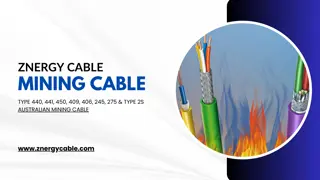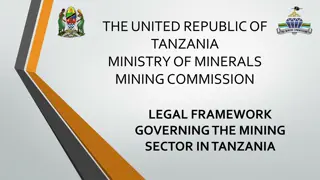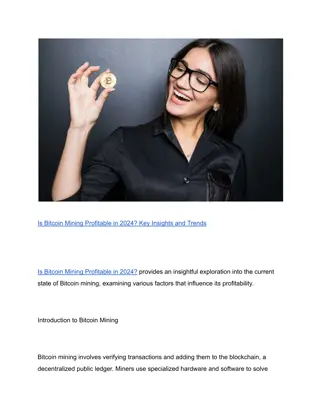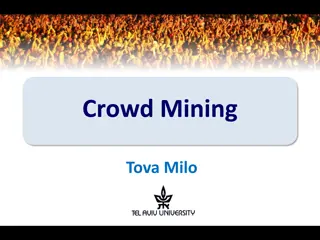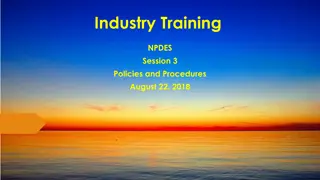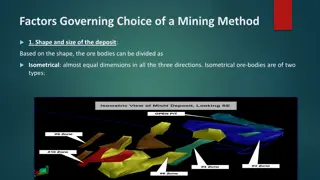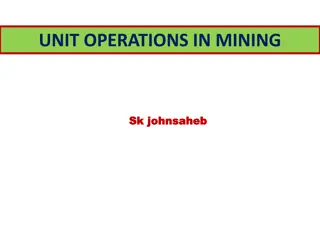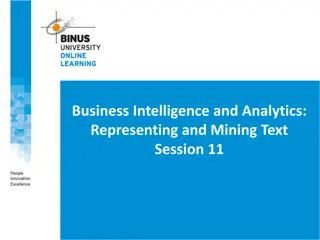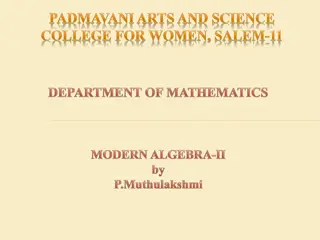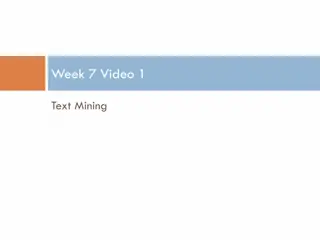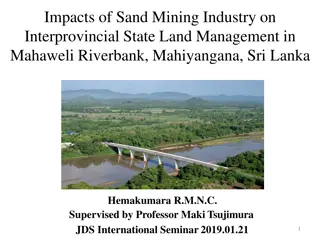The Vector Space Model in Text Mining
Learn how to represent documents computably, infer document relationships, and identify structures using the Vector Space Model. Explore techniques for assigning weights, defining distance metrics, and selecting basic concepts. Discover the importance of orthogonal basic concepts and how they contribute to document characterization. Dive into applications, algorithms, and text mining resources to enhance your knowledge in this field.
Download Presentation

Please find below an Image/Link to download the presentation.
The content on the website is provided AS IS for your information and personal use only. It may not be sold, licensed, or shared on other websites without obtaining consent from the author.If you encounter any issues during the download, it is possible that the publisher has removed the file from their server.
You are allowed to download the files provided on this website for personal or commercial use, subject to the condition that they are used lawfully. All files are the property of their respective owners.
The content on the website is provided AS IS for your information and personal use only. It may not be sold, licensed, or shared on other websites without obtaining consent from the author.
E N D
Presentation Transcript
Vector Space Model Hongning Wang CS@UVa
Todays lecture 1. How to represent a document? Make it computable 2. How to infer the relationship among documents or identify the structure within a document? Knowledge discovery CS@UVa CS6501: Text Mining 2
How to represent a document Represent by a string? No semantic meaning Represent by a list of sentences? Sentence is just like a short document (recursive definition) CS@UVa CS6501: Text Mining 3
Recap: what to read? Applications Algorithms Web Applications, Bioinformatics Machine Learning Pattern Recognition ICML, NIPS, UAI Statistics Optimization Library & Info Science Text Mining Data Mining KDD, ICDM, SDM NLP Information Retrieval SIGIR, WWW, WSDM, CIKM ACL, EMNLP, COLING Find more on course website for resource CS@UVa CS6501: Text Mining 4
Vector space model Represent documents by concept vectors Each concept defines one dimension k concepts define a high-dimensional space Element of vector corresponds to concept weight E.g., d=(x1, ,xk), xiis importance of concept i in d Distance between the vectors in this concept space Relationship among documents CS@UVa CS6501: Text Mining 5
An illustration of VS model All documents are projected into this concept space Finance |D2-D4| D2 D4 D3 Sports D5 D1 Education CS@UVa CS6501: Text Mining 6
What the VS model doesnt say How to define/select the basic concept Concepts are assumed to be orthogonal How to assign weights Weights indicate how well the concept characterizes the document How to define the distance metric CS@UVa CS6501: Text Mining 7
What is a good Basic Concept? Orthogonal Linearly independent basis vectors Non-overlapping in meaning No ambiguity Weights can be assigned automatically and accurately Existing solutions Terms or N-grams, a.k.a., Bag-of-Words Topics We will come back to this later CS@UVa CS6501: Text Mining 8
Bag-of-Words representation Term as the basis for vector space Doc1: Text mining is to identify useful information. Doc2: Useful information is mined from text. Doc3: Apple is delicious. text information identify mining mined is useful to from apple delicious Doc1 1 1 1 1 0 1 1 1 0 0 0 Doc2 1 1 0 0 1 1 1 0 1 0 0 Doc3 0 0 0 0 0 1 0 0 0 1 1 CS@UVa CS6501: Text Mining 9
Tokenization Break a stream of text into meaningful units Tokens: words, phrases, symbols Input:It s not straight-forward to perform so-called tokenization. Output(1):'It s', 'not', 'straight-forward', 'to', 'perform', 'so-called', ' tokenization. ' Output(2):'It', ' ', 's', 'not', 'straight', '-', 'forward, 'to', 'perform', 'so', '-', 'called', ', 'tokenization', '.', ' Definition depends on language, corpus, or even context CS@UVa CS6501: Text Mining 10
Tokenization Solutions Regular expressions [\w]+: so-called -> so , called [\S]+: It s -> It s instead of It , s Statistical methods Explore rich features to decide where the boundary of a word is Apache OpenNLP (http://opennlp.apache.org/) Stanford NLP Parser (http://nlp.stanford.edu/software/lex- parser.shtml) Online Demo Stanford (http://nlp.stanford.edu:8080/parser/index.jsp) UIUC (http://cogcomp.cs.illinois.edu/curator/demo/index.html) We will come back to this later CS@UVa CS6501: Text Mining 11
Bag-of-Words representation text information identify mining mined is useful to from apple delicious Doc1 1 1 1 1 0 1 1 1 0 0 0 Doc2 1 1 0 0 1 1 1 0 1 0 0 Doc3 0 0 0 0 0 1 0 0 0 1 1 Assumption Words are independent from each other Pros Simple Cons Basis vectors are clearly not linearly independent! Grammar and order are missing The most frequently used document representation Image, speech, gene sequence CS@UVa CS6501: Text Mining 12
Bag-of-Words with N-grams N-grams: a contiguous sequence of N tokens from a given piece of text E.g., Text mining is to identify useful information. Bigrams: text_mining , mining_is , is_to , to_identify , identify_useful , useful_information , information_. Pros: capture local dependency and order Cons: a purely statistical view, increase the vocabulary size ?(??) CS@UVa CS6501: Text Mining 13
Automatic document representation Represent a document with all the occurring words Pros Preserve all information in the text (hopefully) Fully automatic Cons Vocabulary gap: cars v.s., car, talk v.s., talking Large storage: N-grams needs ?(??) Solution Construct controlled vocabulary CS@UVa CS6501: Text Mining 14
A statistical property of language Zipf s law Frequency of any word is inversely proportional to its rank in the frequency table Formally Word frequency Discrete version of power law 1/?? ? ? ?;?,? = 1/?? ?=1 where ? is rank of the word; ? is the vocabulary size; ? is language-specific parameter Simply: ? ?;?,? 1/?? Word rank by frequency word occurrences; the second-place word "of" accounts for slightly over 3.5% of words. In the Brown Corpus of American English text, the word "the" is the most frequently occurring word, and by itself accounts for nearly 7% of all A plot of word frequency in Wikipedia (Nov 27, 2006) CS@UVa CS6501: Text Mining 15
Pop-up Quiz In a large Spanish text corpus, if we know the most popular word s frequency is 145,872, what is your best estimate of its second most popular word s frequency? CS@UVa CS6501: Text Mining 16
Zipfs law tells us Head words take large portion of occurrences, but they are semantically meaningless E.g., the, a, an, we, do, to Tail words take major portion of vocabulary, but they rarely occur in documents E.g., sesquipedalianism The rest is most representative To be included in the controlled vocabulary CS@UVa CS6501: Text Mining 17
Automatic document representation Remove non-informative words Remove rare words CS@UVa CS6501: Text Mining 18
Normalization Convert different forms of a word to a normalized form in the vocabulary U.S.A. -> USA, St. Louis -> Saint Louis Solution Rule-based Delete periods and hyphens All in lower cases Dictionary-based Construct equivalent class Car -> automobile, vehicle Mobile phone -> cellphone We will come back to this later CS@UVa CS6501: Text Mining 19
Stemming Reduce inflected or derived words to their root form Plurals, adverbs, inflected word forms E.g., ladies -> lady, referring -> refer, forgotten -> forget Bridge the vocabulary gap Solutions (for English) Porter stemmer: patterns of vowel-consonant sequence Krovetz stemmer: morphological rules Risk: lose precise meaning of the word E.g., lay -> lie (a false statement? or be in a horizontal position?) CS@UVa CS6501: Text Mining 20
Stopwords Useless words for document analysis Not all words are informative Remove such words to reduce vocabulary size No universal definition Risk: break the original meaning and structure of text E.g., this is not a good option -> option to be or not to be -> null The OEC: Facts about the language CS@UVa CS6501: Text Mining 21
Recap: bag-of-words representation text information identify mining mined is useful to from apple delicious Doc1 1 1 1 1 0 1 1 1 0 0 0 Doc2 1 1 0 0 1 1 1 0 1 0 0 Doc3 0 0 0 0 0 1 0 0 0 1 1 Assumption Words are independent from each other Pros Simple Cons Basis vectors are clearly not linearly independent! Grammar and order are missing The most frequently used document representation Image, speech, gene sequence CS@UVa CS6501: Text Mining 22
Recap: a statistical property of language Discrete version of power law Word frequency Word rank by frequency A plot of word frequency in Wikipedia (Nov 27, 2006) CS@UVa CS6501: Text Mining 23
Constructing a VSM representation Naturally fit into MapReduce paradigm! Mapper D1: Text mining is to identify useful information. 1. Tokenization: D1: Text , mining , is , to , identify , useful , information , . 2. Stemming/normalization: D1: text , mine , is , to , identify , use , inform , . 3. N-gram construction: D1: text-mine , mine-is , is-to , to-identify , identify-use , use-inform , inform-. 4. Stopword/controlled vocabulary filtering: D1: text-mine , to-identify , identify-use , use-inform Reducer Documents in a vector space! CS@UVa CS6501: Text Mining 24
How to assign weights? Important! Why? Corpus-wise: some terms carry more information about the document content Document-wise: not all terms are equally important How? Two basic heuristics TF (Term Frequency) = Within-doc-frequency IDF (Inverse Document Frequency) CS@UVa CS6501: Text Mining 25
Term frequency Idea: a term is more important if it occurs more frequently in a document TF Formulas Let ?(?,?) be the frequency count of term ? in doc ? Raw TF: ??(?,?) = ?(?,?) Which two documents are more similar to each other? Doc A: good weather ,10 Doc B: good weather ,2 Doc C: good weather ,3 CS@UVa CS6501: Text Mining 26
TF normalization Two views of document length A doc is long because it is verbose A doc is long because it has more content Raw TF is inaccurate Document length variation Repeated occurrences are less informative than the first occurrence Information about semantic does not increase proportionally with number of term occurrence Generally penalize long document, but avoid over-penalizing Pivoted length normalization CS@UVa CS6501: Text Mining 27
TF normalization Maximum TF scaling ?(?,?) max ? ?? ?,? = ? + (1 ?) ?(?,?), if ? ?,? > 0 Normalize by the most frequent word in this doc Norm. TF 1 ? Raw TF CS@UVa CS6501: Text Mining 28
TF normalization Sub-linear TF scaling ?? ?,? = 1 + log? ?,? ,?? ? ?,? > 0 0,?? ?????? Norm. TF Polya Urn Model Raw TF CS@UVa CS6501: Text Mining 29
Document frequency Idea: a term is more discriminative if it occurs only in fewer documents CS@UVa CS6501: Text Mining 30
Inverse document frequency Solution Assign higher weights to rare terms Formula Non-linear scaling Total number of docs in collection ? ??? ? = 1 + log( ??(?)) Number of docs containing term ? A corpus-specific property Independent of a single document CS@UVa CS6501: Text Mining 31
Pop-up Quiz If we remove one document from the corpus, how would it affect the IDF of words in the vocabulary? If we add one document from the corpus, how would it affect the IDF of words in the vocabulary? CS@UVa CS6501: Text Mining 32
Why document frequency How about total term frequency? ??? ? = ??(?,?) Table 1. Example total term frequency v.s. document frequency in Reuters-RCV1 collection. Word ttf df try 10422 8760 insurance 10440 3997 Cannot recognize words frequently occurring in a subset of documents CS@UVa CS6501: Text Mining 33
TF-IDF weighting Combining TF and IDF Common in doc high tf high weight Rare in collection high idf high weight ? ?,? = ?? ?,? ???(?) Most well-known document representation schema in IR! (G Salton et al. 1983) Salton was perhaps the leading computer scientist working in the field of information retrieval during his time. - wikipedia Gerard Salton Award highest achievement award in IR CS@UVa CS6501: Text Mining 34
How to define a good similarity metric? Euclidean distance? TF-IDF space Finance D2 D4 D3 Sports D6 D5 D1 Education CS@UVa CS6501: Text Mining 35
How to define a good similarity metric? Euclidean distance ???? ??,?? = ? ?[?? ?,????? ? ?? ?,????? ? ]2 Longer documents will be penalized by the extra words We care more about how these two vectors are overlapped CS@UVa CS6501: Text Mining 36
From distance to angle Angle: how vectors are overlapped Cosine similarity projection of one vector onto another TF-IDF space Finance D1 The choice of angle The choice of Euclidean distance D2 D6 Sports CS@UVa CS6501: Text Mining 37
Cosine similarity TF-IDF vector Angle between two vectors ???? ??? ?????? ??,?? = ???2 ???2 Unit vector Documents are normalized by length Finance TF-IDF space D2 D1 D6 Sports CS@UVa CS6501: Text Mining 38
Advantages of VS model Empirically effective! Intuitive Easy to implement Well-studied/mostly evaluated The Smart system Developed at Cornell: 1960-1999 Still widely used Warning: many variants of TF-IDF! CS@UVa CS6501: Text Mining 39
Common Misconceptions Vector space model is bag-of-words Bag-of-words is TF-IDF Cosine similarity is superior to Euclidean distance CS@UVa CS6501: Text Mining 40
Disadvantages of VS model Assume term independence Lack of predictive adequacy Arbitrary term weighting Arbitrary similarity measure Lots of parameter tuning! CS@UVa CS6501: Text Mining 41
What you should know Basic ideas of vector space model Procedures of constructing VS representation for a document Two important heuristics in bag-of-words representation TF IDF Similarity metric for VS model CS@UVa CS6501: Text Mining 42
Todays reading Introduction to information retrieval Chapter 2.2: Determining the vocabulary of terms Chapter 6.2: Term frequency and weighting Chapter 6.3: The vector space model for scoring Chapter 6.4: Variant tf-idf functions CS@UVa CS6501: Text Mining 43






